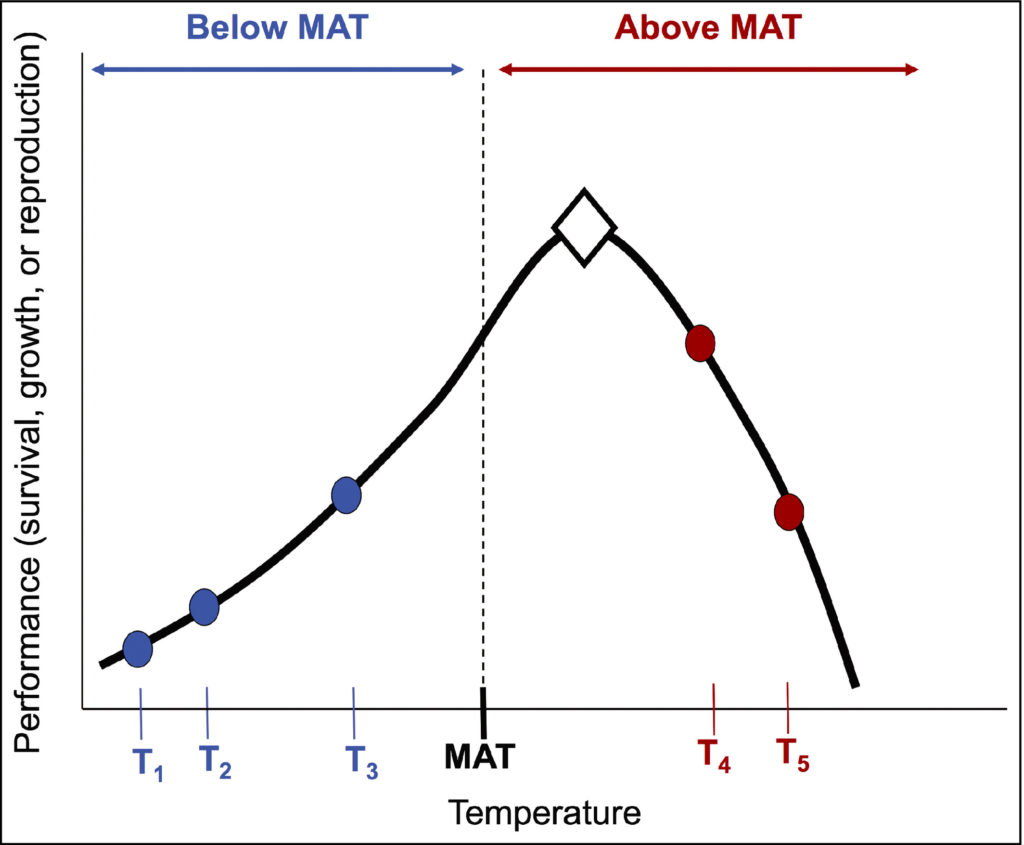When it comes to scientific experimentation, there’s a nearly universal recipe: To increase difficulty, just add water.
For a coastal ecologist like Professor Randall Hughes, the difficult nature of underwater studies can at times translate to incomplete data sets and a murky picture of ocean health. As our climate changes and the oceans warm, researchers want to know how marine life will react, and how our picture of the oceans may change.
Hughes, a Northeastern associate professor of Marine and Environmental Sciences, was determined to provide clarity for marine life after her land-based colleagues came asking for the same type of testing they had, called Common Garden experiments. “They kept asking me, ‘what do we know?’… and I was like, I don’t know what we know. Nobody has looked across all these different experiments,” she said.

The hypothetical example above demonstrates a marine populations growth across a spectrum of mean annual temperatures (MAT). There is a natural incline below MAT, a peak at ideal temperatures (diamond), and a significant decline in above MAT. Graphic provided by Randall Hughes
Her lab focused on gathering data from laboratory experiments, combing through the literature that demonstrated how marine life responded to increased temperature. Using this data, she wanted to predict the health of marine life in varying temperatures.
But there was one key problem: due to the difficult nature of underwater temperature studies, only a subset of the existing data could provide one of the most valued metrics, one that is common in terrestrial experiments. Known as the Thermal Optimum, the measurement predicts the temperature where a species will grow the biggest, survive more stress, and have more offspring.
Gathering the data required for a Thermal Optimum can be a grueling process on land, let alone underwater. There are, therefore, far more temperature experiments that have simpler setups than a true Thermal Optimum. Rather than discard these less specific results, Hughes and her colleagues found a way to get a best guess at the Thermal Optimum, simplifying the science from months of measurement to hours.
The study, called “Predicting the sensitivity of marine populations to rising temperatures,” was co-authored by MSC Postdoctoral Research Associate Torrie Hanley, MSC Alumni PhD Graduates Althea Moore, Robyn Zerebecki, and Christine Newton and published in Frontier in Ecology and the Environment. It centers on a new metric, named the Mean Annual Temperature (MAT), which represented the average temperature over a year in an organism’s environment.
By supposing that plants and animals generally live in environments they are suited for, Hughes and her team were able to essentially approximate the Thermal Optimum. “What we were looking for was a simple but informative metric that could let us make some predictions about which populations were going to be more vulnerable” said Hughes.
Once Hughes had all the data together, she could see that MAT was an excellent substitute for the Thermal Optimum, and by extension, a simple way to how an organism fares in warming waters. “We were really surprised, to be quite honest, at how clear the split was,” she noted.
The MAT divided temperature cleanly into above and below. If the environmental temperature was colder than an organism’s MAT, warming would generally help it succeed in growth, survival, and reproduction. But if the temperature passed the MAT threshold, survival would plummet.
“If we know when and where warming is occurring, it allows us to predict which populations are going to be more vulnerable to that warming than others,” she said.
With the new technique, scientists can now more accurately predict which species are at greater risk. Hughes hopes this work will lead to a broader understanding of ocean health in the face of a changing climate and help build new methods for protecting and restoring marine populations.
“One of the things that’s really hard is knowing, for any kind of management, which species or populations are most vulnerable to that, how should we prioritize our efforts, and try to conserve or restore or protect some of these populations,” she said.
One of the next steps Hughes hopes researchers will take is to dive into how to use this information to restore and manage populations. One way may be to use hardier populations as “sources” for restoration efforts, since they could help bolster susceptible populations against the rise in temperature.
Today, Hughes is working solving this new problem, looking for ways to find a species’ best hope to put forward into a new, warmer world.

